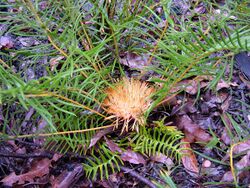Biology:Banksia pellaeifolia
| Banksia pellaeifolia | |
|---|---|

| |
| Near Williams | |
| Scientific classification | |
| Kingdom: | Plantae |
| Clade: | Tracheophytes |
| Clade: | Angiosperms |
| Clade: | Eudicots |
| Order: | Proteales |
| Family: | Proteaceae |
| Genus: | Banksia |
| Subgenus: | Banksia subg. Banksia |
| Series: | Banksia ser. Dryandra |
| Species: | B. pellaeifolia
|
| Binomial name | |
| Banksia pellaeifolia A.R.Mast and K.R.Thiele[1]
| |
| Synonyms[1] | |
Banksia pellaeifolia is a species of shrub that is endemic to the south-west of Western Australia. It has underground stems, deeply pinnatipartite leaves with twenty to thirty lobes on each side, yellowish-brown flowers in heads of about sixty-five, and egg-shaped follicles.
Description
Banksia pellaeifolia is a shrub with hairy, underground, fire-tolerant stems and that typically grows to 1.7 m (5 ft 7 in) in diameter. The leaves are pinnatipartite, 200–350 mm (7.9–13.8 in) long and 50–130 mm (2.0–5.1 in) wide on a petiole 20–40 mm (0.79–1.57 in) long with between twenty and thirty linear, sharply pointed lobes on each side. The flowers are yellowish-brown and arranged in heads of sixty-five with egg-shaped to lance-shaped involucral bracts 35–40 mm (1.4–1.6 in) long at the base of the head. The perianth is 40–47 mm (1.6–1.9 in) long and the pistil 39–45 mm (1.5–1.8 in) long. Flowering occurs from May to August and the follicles are egg-shaped, 18–19 mm (0.71–0.75 in) long with scattered hairs.[2][3]
Taxonomy and naming
This species was first formally described in 1810 by Robert Brown who gave it the name Dryandra blechnifolia and published the description in the Transactions of the Linnean Society of London from specimens collected by Archibald Menzies near King George's Sound.[4] The specific epithet (blechnifolia) was a reference to the fern genus Blechnum with a Latin ending meaning "-leaved".[5]:148
In 2007, Austin Mast and Kevin Thiele transferred all the dryandras to the genus Banksia, but since there was already a species named Banksia blechnifolia, Mast and Thiele gave this species the name Banksia pellaeifolia.[6][7] The epithet (pellaeifolia) refers to the fern genus Pellaea.[5]:273
Distribution and habitat
Banksia pellaeifolia grows in kwongan and is mostly found in the Stirling Range National Park and towards Ongerup.[2][3]
Ecology
An assessment of the potential impact of climate change on this species found that its range is likely to contract by between 50% and 80% by 2080, depending on the severity of the change.[8]
Conservation status
This banksia is classed as "not threatened" by the Western Australian Government Department of Parks and Wildlife.[3]
References
- ↑ 1.0 1.1 "Banksia pellaeifolia". https://biodiversity.org.au/nsl/services/apc-format/display/204998.
- ↑ 2.0 2.1 George, Alex S. (1999). Flora of Australia. 17B. Canberra: Australian Biological Resources Study, Canberra. p. 314. https://www.environment.gov.au/system/files/pages/6d8c5c3b-8545-437e-b9b3-944ac95ee07a/files/flora-australia-17b-proteaceae-3-hakea-dryandra.pdf. Retrieved 22 May 2020.
- ↑ 3.0 3.1 3.2 "Banksia pellaeifolia". FloraBase. Western Australian Government Department of Parks and Wildlife. https://florabase.dpaw.wa.gov.au/browse/profile/32164.
- ↑ "Dryandra blechnifolia". APNI. https://id.biodiversity.org.au/instance/apni/526793.
- ↑ 5.0 5.1 Francis Aubie Sharr (2019). Western Australian Plant Names and their Meanings. Kardinya, Western Australia: Four Gables Press. ISBN 9780958034180.
- ↑ "Banksia pellaeifolia". APNI. https://id.biodiversity.org.au/instance/apni/614056.
- ↑ Mast, Austin R.; Thiele, Kevin (2013). "The transfer of Dryandra R.Br. to Banksia L.f. (Proteaceae)". Australian Systematic Botany 20 (1): 63–71. doi:10.1071/SB06016.
- ↑ Fitzpatrick, Matthew C.; Gove, Aaron D.; Sanders, Nathan J.; Dunn, Robert R. (2008). "Climate change, plant migration, and range collapse in a global biodiversity hotspot: the Banksia (Proteaceae) of Western Australia". Global Change Biology 14 (6): 1–16. doi:10.1111/j.1365-2486.2008.01559.x.
- Cavanagh, Tony; Pieroni, Margaret (2006). The Dryandras. Melbourne: Australian Plants Society (SGAP Victoria); Perth: Wildflower Society of Western Australia. ISBN 1-876473-54-1.
Wikidata ☰ Q4856667 entry
 |

